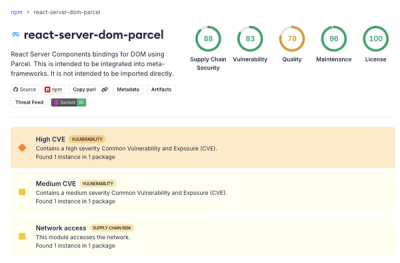
Security News
Deno 2.6 + Socket: Supply Chain Defense In Your CLI
Deno 2.6 introduces deno audit with a new --socket flag that plugs directly into Socket to bring supply chain security checks into the Deno CLI.
cache-manager
Advanced tools
A cache module for NodeJS that allows easy wrapping of functions in cache, tiered caches, and a consistent interface.
nonBlocking option that optimizes how the system handles multiple stores.We moved to using Keyv which are more actively maintained and have a larger community.
A special thanks to Tim Phan who took cache-manager v5 and ported it to Keyv which is the foundation of v6. 🎉 Another special thanks to Doug Ayers who wrote promise-coalesce which was used in v5 and now embedded in v6.
v7 has only one breaking change which is changing the return type from null to undefined when there is no data to return. This is to align with the Keyv API and to make it more consistent with the rest of the methods. Below is an example of how to migrate from v6 to v7:
import { createCache } from 'cache-manager';
const cache = createCache();
const result = await cache.get('key');
// result will be undefined if the key is not found or expired
console.log(result); // undefined
v6 is a major update and has breaking changes primarily around the storage adapters. We have moved to using Keyv which are more actively maintained and have a larger community. Below are the changes you need to make to migrate from v5 to v6. In v5 the memoryStore was used to create a memory store, in v6 you can use any storage adapter that Keyv supports. Below is an example of how to migrate from v5 to v6:
import { createCache, memoryStore } from 'cache-manager';
// Create memory cache synchronously
const memoryCache = createCache(memoryStore({
max: 100,
ttl: 10 * 1000 /*milliseconds*/,
}));
In v6 you can use any storage adapter that Keyv supports. Below is an example of using the in memory store with Keyv:
import { createCache } from 'cache-manager';
const cache = createCache();
If you would like to do multiple stores you can do the following:
import { createCache } from 'cache-manager';
import { createKeyv } from 'cacheable';
import { createKeyv as createKeyvRedis } from '@keyv/redis';
const memoryStore = createKeyv();
const redisStore = createKeyvRedis('redis://user:pass@localhost:6379');
const cache = createCache({
stores: [memoryStore, redisStore],
});
When doing in memory caching and getting errors on symbol or if the object is coming back wrong like on Uint8Array you will want to set the serialization and deserialization options in Keyv to undefined as it will try to do json serialization.
import { createCache } from "cache-manager";
import { Keyv } from "keyv";
const keyv = new Keyv();
keyv.serialize = undefined;
keyv.deserialize = undefined;
const memoryCache = createCache({
stores: [keyv],
});
The other option is to set the serialization to something that is not JSON.stringify. You can read more about it here: https://keyv.org/docs/keyv/#custom-serializers
If you would like a more robust in memory storage adapter you can use CacheableMemory from Cacheable. Below is an example of how to migrate from v5 to v6 using CacheableMemory:
import { createCache } from 'cache-manager';
import { createKeyv } from 'cacheable';
const cache = createCache({
stores: [createKeyv({ ttl: 60000, lruSize: 5000 })],
});
To learn more about CacheableMemory please visit: http://cacheable.org/docs/cacheable/#cacheablememory---in-memory-cache
If you are still wanting to use the legacy storage adapters you can use the KeyvAdapter to wrap the storage adapter. Below is an example of how to migrate from v5 to v6 using cache-manager-redis-yet by going to Using Legacy Storage Adapters.
If you are looking for older documentation you can find it here:
CacheableMemory or lru-cache as storage adapterredis and ioredis Supportnpm install cache-manager
By default, everything is stored in memory; you can optionally also install a storage adapter; choose one from any of the storage adapters supported by Keyv:
npm install @keyv/redis
npm install @keyv/memcache
npm install @keyv/mongo
npm install @keyv/sqlite
npm install @keyv/postgres
npm install @keyv/mysql
npm install @keyv/etcd
In addition Keyv supports other storage adapters such as lru-cache and CacheableMemory from Cacheable (more examples below). Please read Keyv document for more information.
import { Keyv } from 'keyv';
import { createCache } from 'cache-manager';
// Memory store by default
const cache = createCache()
// Single store which is in memory
const cache = createCache({
stores: [new Keyv()],
})
Here is an example of doing layer 1 and layer 2 caching with the in-memory being CacheableMemory from Cacheable and the second layer being @keyv/redis:
import { Keyv } from 'keyv';
import KeyvRedis from '@keyv/redis';
import { CacheableMemory } from 'cacheable';
import { createCache } from 'cache-manager';
// Multiple stores
const cache = createCache({
stores: [
// High performance in-memory cache with LRU and TTL
new Keyv({
store: new CacheableMemory({ ttl: 60000, lruSize: 5000 }),
}),
// Redis Store
new Keyv({
store: new KeyvRedis('redis://user:pass@localhost:6379'),
}),
],
})
Once it is created, you can use the cache object to set, get, delete, and wrap functions in cache.
// With default ttl and refreshThreshold
const cache = createCache({
ttl: 10000,
refreshThreshold: 3000,
})
await cache.set('foo', 'bar')
// => bar
await cache.get('foo')
// => bar
await cache.del('foo')
// => true
await cache.get('foo')
// => null
await cache.wrap('key', () => 'value')
// => value
Because we are using Keyv, you can use any storage adapter that Keyv supports such as lru-cache or CacheableMemory from Cacheable. Below is an example of using CacheableMemory:
In this example we are using CacheableMemory from Cacheable which is a fast in-memory cache that supports LRU and and TTL expiration.
import { createCache } from 'cache-manager';
import { Keyv } from 'keyv';
import { KeyvCacheableMemory } from 'cacheable';
const store = new KeyvCacheableMemory({ ttl: 60000, lruSize: 5000 });
const keyv = new Keyv({ store });
const cache = createCache({ stores: [keyv] });
Here is an example using lru-cache:
import { createCache } from 'cache-manager';
import { Keyv } from 'keyv';
import { LRU } from 'lru-cache';
const keyv = new Keyv({ store: new LRU({ max: 5000, maxAge: 60000 }) });
const cache = createCache({ stores: [keyv] });
stores?: Keyv[]
List of Keyv instance. Please refer to the Keyv document for more information.
ttl?: number - Default time to live in milliseconds.
The time to live in milliseconds. This is the maximum amount of time that an item can be in the cache before it is removed.
refreshThreshold?: number | (value:T) => number - Default refreshThreshold in milliseconds. You can also provide a function that will return the refreshThreshold based on the value.
If the remaining TTL is less than refreshThreshold, the system will update the value asynchronously in background.
refreshAllStores?: boolean - Default false
If set to true, the system will update the value of all stores when the refreshThreshold is met. Otherwise, it will only update from the top to the store that triggered the refresh.
nonBlocking?: boolean - Default false
If set to true, the system will not block when multiple stores are used. Here is how it affects the type of functions:
set and mset - will not wait for all stores to finish.get and mget - will return the first (fastest) value found.del and mdel - will not wait for all stores to finish.clear - will not wait for all stores to finish.wrap - will do the same as get and set (return the first value found and not wait for all stores to finish).cacheId?: string - Defaults to random string
Unique identifier for the cache instance. This is primarily used to not have conflicts when using wrap with multiple cache instances.
set(key, value, [ttl]): Promise<value>
Sets a key value pair. It is possible to define a ttl (in milliseconds). An error will be throw on any failed
await cache.set('key-1', 'value 1')
// expires after 5 seconds
await cache.set('key 2', 'value 2', 5000)
See unit tests in test/set.test.ts for more information.
mset(keys: [ { key, value, ttl } ]): Promise<true>
Sets multiple key value pairs. It is possible to define a ttl (in milliseconds). An error will be throw on any failed
await cache.mset([
{ key: 'key-1', value: 'value 1' },
{ key: 'key-2', value: 'value 2', ttl: 5000 },
]);
get(key): Promise<value>
Gets a saved value from the cache. Returns a null if not found or expired. If the value was found it returns the value.
await cache.set('key', 'value')
await cache.get('key')
// => value
await cache.get('foo')
// => null
See unit tests in test/get.test.ts for more information.
mget(keys: [key]): Promise<value[]>
Gets multiple saved values from the cache. Returns a null if not found or expired. If the value was found it returns the value.
await cache.mset([
{ key: 'key-1', value: 'value 1' },
{ key: 'key-2', value: 'value 2' },
]);
await cache.mget(['key-1', 'key-2', 'key-3'])
// => ['value 1', 'value 2', null]
ttl(key): Promise<number | null>
Gets the expiration time of a key in milliseconds. Returns a null if not found or expired.
await cache.set('key', 'value', 1000); // expires after 1 second
await cache.ttl('key'); // => the expiration time in milliseconds
await cache.get('foo'); // => null
See unit tests in test/ttl.test.ts for more information.
del(key): Promise<true>
Delete a key, an error will be throw on any failed.
await cache.set('key', 'value')
await cache.get('key')
// => value
await cache.del('key')
await cache.get('key')
// => null
See unit tests in test/del.test.ts for more information.
mdel(keys: [key]): Promise<true>
Delete multiple keys, an error will be throw on any failed.
await cache.mset([
{ key: 'key-1', value: 'value 1' },
{ key: 'key-2', value: 'value 2' },
]);
await cache.mdel(['key-1', 'key-2'])
clear(): Promise<true>
Flush all data, an error will be throw on any failed.
await cache.set('key-1', 'value 1')
await cache.set('key-2', 'value 2')
await cache.get('key-1')
// => value 1
await cache.get('key-2')
// => value 2
await cache.clear()
await cache.get('key-1')
// => null
await cache.get('key-2')
// => null
See unit tests in test/clear.test.ts for more information.
wrap(key, fn: async () => value, [ttl], [refreshThreshold]): Promise<value>
Alternatively, with optional parameters as options object supporting a raw parameter:
wrap(key, fn: async () => value, { ttl?: number, refreshThreshold?: number, raw?: true }): Promise<value>
Wraps a function in cache. The first time the function is run, its results are stored in cache so subsequent calls retrieve from cache instead of calling the function.
If refreshThreshold is set and the remaining TTL is less than refreshThreshold, the system will update the value asynchronously. In the meantime, the system will return the old value until expiration. You can also provide a function that will return the refreshThreshold based on the value (value:T) => number.
If the object format for the optional parameters is used, an additional raw parameter can be applied, changing the function return type to raw data including expiration timestamp as { value: [data], expires: [timestamp] }.
await cache.wrap('key', () => 1, 5000, 3000)
// call function then save the result to cache
// => 1
await cache.wrap('key', () => 2, 5000, 3000)
// return data from cache, function will not be called again
// => 1
await cache.wrap('key', () => 2, { ttl: 5000, refreshThreshold: 3000, raw: true })
// returns raw data including expiration timestamp
// => { value: 1, expires: [timestamp] }
// wait 3 seconds
await sleep(3000)
await cache.wrap('key', () => 2, 5000, 3000)
// return data from cache, call function in background and save the result to cache
// => 1
await cache.wrap('key', () => 3, 5000, 3000)
// return data from cache, function will not be called
// => 2
await cache.wrap('key', () => 4, 5000, () => 3000);
// return data from cache, function will not be called
// => 4
await cache.wrap('error', () => {
throw new Error('failed')
})
// => error
NOTES:
ttl is set for the key, the refresh mechanism will not be triggered.See unit tests in test/wrap.test.ts for more information.
disconnect(): Promise<void>
Will disconnect from the relevant store(s). It is highly recommended to use this when using a Keyv storage adapter that requires a disconnect. For each storage adapter, the use case for when to use disconnect is different. An example is that @keyv/redis should be used only when you are done with the cache.
await cache.disconnect();
See unit tests in test/disconnect.test.ts for more information.
cacheId(): string
Returns cache instance id. This is primarily used to not have conflicts when using wrap with multiple cache instances.
stores(): Keyv[]
Returns the list of Keyv instances. This can be used to get the list of stores and then use the Keyv API to interact with the store directly.
const cache = createCache({cacheId: 'my-cache-id'});
cache.cacheId(); // => 'my-cache-id'
See unit tests in test/cache-id.test.ts for more information.
Fired when a key has been added or changed.
cache.on('set', ({ key, value, error }) => {
// ... do something ...
})
Fired when a key has been removed manually.
cache.on('del', ({ key, error }) => {
// ... do something ...
})
Fired when the cache has been flushed.
cache.on('clear', (error) => {
if (error) {
// ... do something ...
}
})
Fired when the cache has been refreshed in the background.
cache.on('refresh', ({ key, value, error }) => {
if (error) {
// ... do something ...
}
})
See unit tests in test/events.test.ts for more information.
You can use the stores method to get the list of stores and then use the Keyv API to interact with the store directly. Below is an example of iterating over all stores and getting all keys:
import Keyv from 'keyv';
import { createKeyv } from '@keyv/redis';
import { createCache } from 'cache-manager';
const keyv = new Keyv();
const keyvRedis = createKeyv('redis://user:pass@localhost:6379');
const cache = createCache({
stores: [keyv, keyvRedis],
});
// add some data
await cache.set('key-1', 'value 1');
await cache.set('key-2', 'value 2');
// get the store you want to iterate over. In this example we are using the second store (redis)
const store = cache.stores[1];
if(store?.iterator) {
for await (const [key, value] of store.iterator({})) {
console.log(key, value);
}
}
WARNING: Be careful when using iterator as it can cause major performance issues with the amount of data being retrieved. Also, Not all storage adapters support iterator so you may need to check the documentation for the storage adapter you are using.
We will not be supporting cache-manager-ioredis-yet or cache-manager-redis-yet in the future as we have moved to using Keyv as the storage adapter @keyv/redis.
There are many storage adapters built for cache-manager and because of that we wanted to provide a way to use them with KeyvAdapter. Below is an example of using cache-manager-redis-yet:
import { createCache, KeyvAdapter } from 'cache-manager';
import { Keyv } from 'keyv';
import { redisStore } from 'cache-manager-redis-yet';
const adapter = new KeyvAdapter( await redisStore() );
const keyv = new Keyv({ store: adapter });
const cache = createCache({ stores: [keyv]});
This adapter will allow you to add in any storage adapter. If there are issues it needs to follow CacheManagerStore interface.
If you would like to contribute to the project, please read how to contribute here CONTRIBUTING.md.
node-cache is an in-memory caching package similar to cache-manager's memory store. It offers a simple and fast caching solution but does not support multiple backends or a tiered caching system.
lru-cache is an in-memory cache that implements the LRU (Least Recently Used) eviction policy. Unlike cache-manager, it is specifically tailored for LRU caching and does not support multiple storage backends.
keyv is a simple key-value storage with support for multiple backends, including Redis, MongoDB, SQLite, and more. It provides a unified interface across different stores but does not have built-in support for multi-level caching.
FAQs
Cache Manager for Node.js
The npm package cache-manager receives a total of 2,028,683 weekly downloads. As such, cache-manager popularity was classified as popular.
We found that cache-manager demonstrated a healthy version release cadence and project activity because the last version was released less than a year ago. It has 1 open source maintainer collaborating on the project.
Did you know?

Socket for GitHub automatically highlights issues in each pull request and monitors the health of all your open source dependencies. Discover the contents of your packages and block harmful activity before you install or update your dependencies.

Security News
Deno 2.6 introduces deno audit with a new --socket flag that plugs directly into Socket to bring supply chain security checks into the Deno CLI.

Security News
New DoS and source code exposure bugs in React Server Components and Next.js: what’s affected and how to update safely.

Security News
Socket CEO Feross Aboukhadijeh joins Software Engineering Daily to discuss modern software supply chain attacks and rising AI-driven security risks.